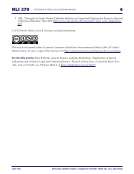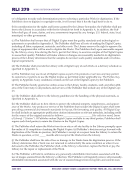June 2012 Research Library Issues: A QuarterlLy Report from ARL, CNI, and SPARC
RLI 279 3
Digitization of Special Collections and Archives
and responsibilities. Based on Peter Hirtle’s good work in surveying the landscape, the working group
presents here two generic documents that conform to the two approaches. ARL institutions can select the
model that best suits their expectations and the style of their legal advisors and use it to craft their own
document. The ARL models were derived from documents developed at UCLA and the University of
Minnesota the working group thanks them for their permission to adapt their documents. Developing
community standards that recognize explicitly enhanced access via digitization will go a long way in
making such use of special collections materials a commonplace practice.
ARL’s “Principles to Guide Vendor/Publisher Relations in Large-Scale Digitization Projects of Special
Collections Materials” articulates some general guidelines that libraries should follow when outsourcing
digitization projects to commercial vendors.3 The document does not specify, however, the precise
contractual terms that would implement its principles. The working group, therefore, has prepared a
Model Digitization Agreement that reflects the latest thinking on what should be included in a vendor’s
contract. In the event that a vendor does not have a standard agreement in place, the model agreement can
serve as the basis for discussion. Even if the vendor has developed and wants to use its own agreement,
as is likely to be the case, the model agreement can still be used as a check to ensure that provisions
important to the library are either present or are added to the vendor’s pre-existing document. Peter
Hirtle developed ARL’s Model Digitization Agreement based in part on a model agreement produced by
the Copyright Advisory Office of Columbia University Libraries, led by Kenneth D. Crews, Director.
Finally, this issue of RLI includes a piece by Kevin Smith, Director of Scholarly Communications
at Duke University, and author of the popular blog Scholarly Communications @Duke. Smith’s article,
“Copyright Risk Management: Principles and Strategies for Large-Scale Digitization Projects in Special
Collections,” explores risk aversion or tolerance in matters of copyright within the broader context of risk
that large organizations regularly confront and manage. The article, synthesizing recent professional
trends, advocates for new practices within both the confines of and the opportunities inherent in the
complexity of copyright law.
The working group hopes this set of documents is useful to ARL libraries in advancing digital
access to critical scholarly materials. ARL welcomes questions and comments about this material and
suggestions of other concerns in transforming special collections in the digital age please direct feedback
to Judy Ruttenberg, judy@arl.org.
1 The working group members are: Anne Kenney, Chair (Cornell University) H. Austin Booth
(University at Buffalo, SUNY) Susan Brynteson (University of Delaware) Jackie Dooley (OCLC
Research) Joshua Greenberg (Sloan Foundation) Nancy Gwinn (Smithsonian Institution)
Thomas Hickerson (University of Calgary) Clifford Lynch (CNI) Ingrid Parent (University of
British Columbia) Steven Smith (University of Tennessee, Knoxville) Gary Strong (University of
California, Los Angeles) Ann Thornton (New York Public Library) Tyler Walters (Virginia Tech)
Karin Wittenborg (University of Virginia). Staff liaisons to the working group are Lisa Carter (ARL
Visiting Program Officer/Ohio State University) and Judy Ruttenberg (ARL).
2 ARL Center for Social Media, School of Communication, American University Program on
Information Justice and Intellectual Property, Washington College of Law, American University
Code of Best Practices in Fair Use for Academic and Research Libraries (Washington, DC: ARL, 2012),
http://www.arl.org/fairuse.
RLI 279 3
Digitization of Special Collections and Archives
and responsibilities. Based on Peter Hirtle’s good work in surveying the landscape, the working group
presents here two generic documents that conform to the two approaches. ARL institutions can select the
model that best suits their expectations and the style of their legal advisors and use it to craft their own
document. The ARL models were derived from documents developed at UCLA and the University of
Minnesota the working group thanks them for their permission to adapt their documents. Developing
community standards that recognize explicitly enhanced access via digitization will go a long way in
making such use of special collections materials a commonplace practice.
ARL’s “Principles to Guide Vendor/Publisher Relations in Large-Scale Digitization Projects of Special
Collections Materials” articulates some general guidelines that libraries should follow when outsourcing
digitization projects to commercial vendors.3 The document does not specify, however, the precise
contractual terms that would implement its principles. The working group, therefore, has prepared a
Model Digitization Agreement that reflects the latest thinking on what should be included in a vendor’s
contract. In the event that a vendor does not have a standard agreement in place, the model agreement can
serve as the basis for discussion. Even if the vendor has developed and wants to use its own agreement,
as is likely to be the case, the model agreement can still be used as a check to ensure that provisions
important to the library are either present or are added to the vendor’s pre-existing document. Peter
Hirtle developed ARL’s Model Digitization Agreement based in part on a model agreement produced by
the Copyright Advisory Office of Columbia University Libraries, led by Kenneth D. Crews, Director.
Finally, this issue of RLI includes a piece by Kevin Smith, Director of Scholarly Communications
at Duke University, and author of the popular blog Scholarly Communications @Duke. Smith’s article,
“Copyright Risk Management: Principles and Strategies for Large-Scale Digitization Projects in Special
Collections,” explores risk aversion or tolerance in matters of copyright within the broader context of risk
that large organizations regularly confront and manage. The article, synthesizing recent professional
trends, advocates for new practices within both the confines of and the opportunities inherent in the
complexity of copyright law.
The working group hopes this set of documents is useful to ARL libraries in advancing digital
access to critical scholarly materials. ARL welcomes questions and comments about this material and
suggestions of other concerns in transforming special collections in the digital age please direct feedback
to Judy Ruttenberg, judy@arl.org.
1 The working group members are: Anne Kenney, Chair (Cornell University) H. Austin Booth
(University at Buffalo, SUNY) Susan Brynteson (University of Delaware) Jackie Dooley (OCLC
Research) Joshua Greenberg (Sloan Foundation) Nancy Gwinn (Smithsonian Institution)
Thomas Hickerson (University of Calgary) Clifford Lynch (CNI) Ingrid Parent (University of
British Columbia) Steven Smith (University of Tennessee, Knoxville) Gary Strong (University of
California, Los Angeles) Ann Thornton (New York Public Library) Tyler Walters (Virginia Tech)
Karin Wittenborg (University of Virginia). Staff liaisons to the working group are Lisa Carter (ARL
Visiting Program Officer/Ohio State University) and Judy Ruttenberg (ARL).
2 ARL Center for Social Media, School of Communication, American University Program on
Information Justice and Intellectual Property, Washington College of Law, American University
Code of Best Practices in Fair Use for Academic and Research Libraries (Washington, DC: ARL, 2012),
http://www.arl.org/fairuse.
























